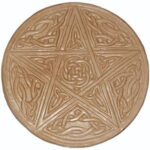In the wizarding world of Harry Potter, magical spells are the quintessential tool of the wizard and the witch. They are the language of magic. With a swish and flick of a wand, and some choice magical words, Harry and his like get to do stuff that we Muggles can only drool about.
This Muggle’s Guide to wizardly spells delves into the origins, meanings and purposes of these powerful, magical words. It profiles more than 101 magical spells drawn from the first six books of the Harry Potter Series. And as the world awaits the release of the seventh and final book, this is as good a time as any to brush upon your charms and spells. (You don’t want to be lost for words the next time you swish and flick your magic wand!). Let’s get started…
A
Accio!
Word Origin: The Latin word accio (I summon, I call)
Purpose: A charm used to summon a desired object to the spell-caster.
Example: In Harry Potter and the Goblet of Fire, Harry used this charm during the Triwizard Tournament to summon his Firebolt broomstick.
Aguamenti!
Word Origin: From the Latin aqua, from Spanish agua (water), and from Latin mente (mind)
Purpose: A charm used to conjure a jet of water from the tip of the witch or wizard’s wand.
Example: In Harry Potter and the Half-Blood Prince, when a Death Eater sets Hagrid’s hut on fire, Harry uses this charm to douse the flames.
Alohomora!
Word Origin: From the Hawaiian word Aloha (farewell) and the Latin word mora (obstacle)
Purpose: A spell that is used to unlock and open doors and windows.
Example: In Harry Potter and the Philosopher’s Stone, Hermione Granger uses this spell to open the door to Fluffy’s room, so that she, Ron and Harry can hide from Mrs. Norris and Filch.
Anapneo!
Word Origin: From the Greek word anapneo (I breathe)
Purpose: A spell used to clear blocked airways, and thus relieving choking.
Example: In Harry Potter and the Half-Blood Prince, Professor Slughorn cast this spell on Marcus Belby, when Marcus choked on a rather large mouthful of pheasant in his haste to answer Slughorn’s question.
Aparecium!
Word Origin: From the Latin apparere (to appear) or aperio (to discover, uncover, reveal or lay bear).
Purpose: This spell is used to make invisible ink visible.
Example: In Harry Potter and the Chamber of Secrets, Hermione Granger cast this spell on Tom Marvolo Riddle’s diary to try to make any hidden writing appear.
Avada Kedavra!
Word Origin: From the conjurer’s magical phrase Abra-cadabra, which is in turn derived from the ancient Aramaic spell abhadda kedhabhra, meaning “disappear like this word” or “I will destroy as I speak.”
Purpose: This is the Killing Curse. It instantly kills whomever it is cast upon, and leaves behind no physical evidence as to the cause of death. It cannot be blocked by any magical means, and only two people have survived it – Harry and Lord Voldemort. The Killing Curse is the third of the three “Unforgivable Curses” and is strictly forbidden. Casting this spell would land the wizard in the dreaded Azkaban Prison. (See also Crucio and Imperio). When this spell is cast, a flash of green light is emitted from the spell-caster’s wand.
Example: In Harry Potter and the Goblet of Fire, this is the curse used by Lord Voldermort to kill Harry Potter’s parents, and by Peter Pettigrew to kill Diggory.
Avis!
Word Origin: From the Latin avis (bird)
Purpose: This charm conjures a flock of little birds from the caster’s wand.
Example: In Harry Potter and the Goblet of Fire, Mr. Ollivander used this spell to test Viktor Krum’s wand.
B
Babbling Curse
Purpose: The effect of this curse is not specified, but it may be safe to assume that it causes the victim to babble uncontrollably.
Example: In Harry Potter and the Chamber of Secrets, Gilderoy Lockhart claims that he cured a “simple Transylvanian villager” of this curse.
Banishing Charm
Purpose: This charm is the reverse of Accio, the summoning charm; it sends the target object away from the caster, “banishing” it.
Example: In Harry Potter and the Goblet of Fire, Harry’s class learns this spell in their 4th year charms class. The charms professor, Filius Flitwick, is sent flying across the room when Neville Longbottom attempts to cast this spell.
Bat-Boogey Hex
Word Origin: “Boogey” is a British slang word for dried mucus, similar to the American word “boogers”
Purpose: This hex causes a subject’s boogies to transform into winged, bat-size imps, which attack the victim’s face. Ginny Wesley is especially accomplished at casting this nasty spell.
Example: In Harry Potter and the Order of the Phoenix, Ginny uses this hex on Draco Malfoy in order to escape from Umbridge’s office.
Bewitched Sleep
Purpose: This charm is used to put the target into a deep sleep-like state, during which he or she does not need to breathe.
Example: In Harry Potter and the Goblet of Fire, during the second Triwizard task, Dumbledore casts this spell on Hermione, Ron, Cho and Gabrielle Delacour, when they are left in the care of the mere-people.
Boil-covering Spell
Purpose: This spell has the effect of causing boils to break out all over the target’s body.
Example: In Harry Potter and the Chamber of Secrets, the twins George and Fred cast this spell on themselves, in the hopes of comforting Ginny and cheering her up. They took turns covering themselves in boils or fur and then jumping out at her from behind the statues.
Bubble-Head Charm
Purpose: This charm is used to enclose the caster’s head in a large air-bubble, providing breathing air for a period of time.
Example: In Harry Potter and the Goblet of Fire, in the second task of the Triwizard, Cedric and Fleur cast this spell, which enabled them to breath underwater.
C
Colloportus!
Word Origin: From the French words Coller (to stick, glue) and port (door), originally from Latin portus
Purpose: This charm is used to lock or seal a door. Ironically, anything locked by the Colloportus charm can be unlocked using the “Alohomora” Charm (see above). As such, it is most effective when used against a muggle or a wandless witch or wizard.
Example: InHarry Potter and the Order of the Phoenix, Hermione casts this spell against some Death Eaters in the Department of Mysteries, hoping to keep them out. The Death Eaters simply unlocked the door with “Alohomora.” However, the spell is not of much use unless dealing with Muggles or a wandless wizard or witch, because the Alohomora Charm will unlock anything locked by “Colloportus!”
Confundus Spell
Word Origin: From the Latin confundere (to confuse)
Purpose: This spell has the effect of temporarily causing confusion in a victim’s mind.
Example: In Harry Potter and the Half-Blood Prince, at the Qudditch team tryouts for the position of goal keeper, Hermione Granger casts this spell on Cormac McLaggen to jinx him into missing a save, and thereby losing out to Ron Weasley.
Colloportus!
Word Origin: From the French words Coller (to stick, glue) and port (door), originally from Latin portus
Purpose: This charm is used to lock or seal a door. Ironically, anything locked by the Colloportus!charm can be unlocked using the “Alohomora” Charm (see above). As such, it is most effective when used against a muggle or a wandless witch or wizard.
Example: In Harry Potter and the Order of the Phoenix, Hermione casts this spell against some Death Eaters in the Department of Mysteries, hoping to keep them out. The Death Eaters simply unlocked the door with “Alohomora.” However, the spell is not of much use unless dealing with Muggles or a wandless wizard or witch, because the Alohomora Charm will unlock anything locked by “Colloportus!”
Conjunctivitis Curse
Word Origin: From the Latin Conjunctiva (the eye’s inner membrane), and itis (inflammation). More commonly called the “pink-eye” disease, Conjunctivitis is the inflammation of the conjuctiva.
Purpose: This curse affects the victim’s vision, making it difficult to see.
Example: In Harry Potter and the Goblet of Fire, in the very first task of the Triwizard tournament, Viktor Krum used this curse on the Chinese fireball.
Conjuring Spell
Word Origin: From Old.French (Conjurer)
Purpose: This spell is used to conjure objects out of thin air
Example: In Harry Potter and the Order of the Phoenix, it is used several times through the books for everything from chairs, to liquid, to even sleeping bags. At Hogwarts, these spells are taught in the sixth and seventh years
Crucio!
Word Origin: From the Latin crucio, literally meaning, “I crucify,” which also refers to the ancient Roman form of torture.
Purpose: This is the incantation for the Cruciatus Curse, second of the three “Unforgivable Sins.” Casting this spell is punishable by life imprisonment at Azkaban, the wizard prison. It inflicts intense, torturous pain on the victim.
Example: In Harry Potter and the Goblet of Fire Voldemort’s Death Eaters cast this spell on Frank and Alice Longbottom, Neville Longbottom’s parents, torturing them to the point of insanity. For this, they were banished to Azkaban.
Cushioning Charm
Purpose: This charm was invented by Elliot Smethwyk in 1820. It is used in the manufacture of flying broomsticks to create an invisible cushion for the broom’s rider.
Example: In Quidditch Through the Ages, the illustrations in the Harry Potter books depict a broom’s rider “floating” above the handle, rather than sitting right on top of it.
(Next – Part 2: D-F)






